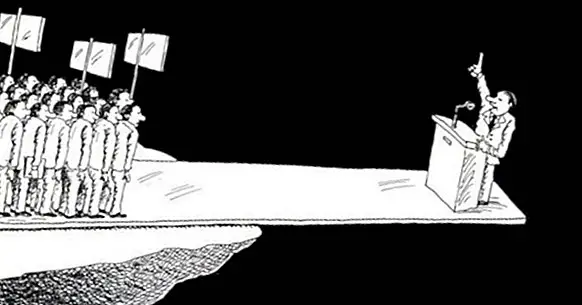Gregariousness: the Bandwagon effect and the Underdog effect
The human being is a gregarious being by nature . As such, it is subject to interaction with other people, who enjoy their own points of view about the reality of the world around them. Therefore, the opinion of the community has always been a reference to guide their own behavior.
Currently, one of the ways to be aware of the opinion of communities is through the media, which allow information through elements such as opinion polls on the beliefs and visions of citizens on specific issues . These opinions provoke different effects in those who receive them, including two opposing ones: Bandwagon effect and the Underdog effect.
Then we will see what they are, but first, let's see what exactly an opinion poll consists of.
What is an opinion poll?
It is considered a public opinion survey that consultation made to people chosen according to statistical principles, being an essential tool for assessing public opinion .
The functions of this type of consultations are to produce knowledge, optimize decision making based on the opinions of others, inform the beliefs of our peers and have the possibility of using them propagandistically.
The results of the surveys will reflect different evaluations according to the subject of which they treat; Among these opinions there may be one that enjoys clear popularity.
Bandwagon effect
In this context, it is in which the Bandwagon effect , according to which people tend to support those causes that we consider as winners .
The Bandwagon effect is based on the need to be consistent with the whole of society, to be part of the group and to make a personal reaffirmation by supporting what we believe is most likely to be successful. In this way, the individual feels a winning part, reinforcing their self-esteem and their feeling of belonging to a reinforcing collective.
When does the Bandwagon effect appear?
Regardless of its use as part of various persuasion techniques, studies indicate that this effect occurs when there is a very clear polarization in favor of one of the options for action or decision.
It occurs especially in individuals with a high level of extraversion and neuroticism, in circumstances where the information on the subject in question is limited and biased by the dominant opinion. The indecisive individuals with respect to which option to choose also they tend to vote for the option that presents itself as the winner unless other variables come into play .
However, we must bear in mind that knowledge of the attitudes of the majority collected by mechanisms such as opinion polls can bias individual freedom, causing a kind of learned helplessness and make the viewer believe that if their actions or thoughts are different from the majority will not have any repercussion. In reaction to this, in some people the distaste and disenchantment towards the majority position may appear , appearing in turn a feeling of sympathy towards what we consider a losing cause.
Underdog effect
The aforementioned effect in which the opinion of the majority provokes a rejection and awakens a sympathy for the minority is the Underdog effect . In this effect, the decision taken will be the one that benefits the option that is perceived as less valued. Thus, it is considered the least valued option as unjustly attacked or underestimated, which provokes its defense.
The causes of the Underdog effect can be multiple, as can be an attempt to differentiate yourself from the rest , to feel sorry for the situation of the "lost cause" or to admire the will of the other to oppose the majority.
His influence on social movements
Both the Bandwagon effect and the Underdog effect are guarantors of the appearance, maintenance and disappearance of social movements. It must be taken into account that the opinion of our peers is relevant when it comes to talking about changing attitudes.
While, as a general rule, as the studies show, majorities do not require a great deal of time or effort to direct the attitude of individuals, as they tend to try to reinforce their sense of belonging to society. Through compliance with social norms, minorities need a long period of time in which they need to maintain internal coherence and consistency in their demands in order to provoke a change in attitude in others.
First, some components of the majority group perceive that the demand is fair and change their perspective. Later, this change causes others to follow his example and finally the opinion before minority .
The case of feminist and anti-racist movements
Examples of the phenomenon described were the feminist movements, those defending the rights of the African-American population and more currently the movements in favor of LGBT rights.
These groups, initially, had the frontal opposition of most of the population. However, the internal consistency, consistency and consistency over time of their demands made some of the individuals who supported the dominant opinion will change their opinion (initially producing an Underdog effect). Over the years, the trend has reversed, becoming the majority attitude once disadvantaged attitude and favoring through a Bandwagon effect the acceptance of collective rights.
However, even though, as we have just seen, these effects can be applied in a positive way, knowing their existence can also cause them to be used in an interested way.
The partisan political use
The knowledge of the Bandwagon and Underdog effects has meant that in many cases they have tried to direct with very specific purposes. One of the dimensions where the study of these effects is tried most is in politics, from which there has been an attempt to employ both media and opinion polls in a propagandistic way considering that knowledge of the opinion of others will modify the behavior and beliefs in the desired direction.
Politicians are aware that many times, when favorable polls are published and disseminated, the mood of the militants of their party is strengthened, while the number of sympathizers increases.
For it, the different political options will try to present opinion polls as favorable as possible to their proposal (given the greater ease that the population subscribes to the majority opinion), presenting them in the media in order to expand the view that their proposal is the one that will be the winner, or at least the one that is in boom.
This fact could help explain why, after the election results and regardless of what these are, all political forces say they consider themselves winners before the media. It is sought that the subjects who are not completely related to their positions change their attitudes to join and feel part of the social majority.

Conclusions
As we have seen, throughout history, the Underdog and Bandwagon effects have appeared and / or been applied, influencing the masses. In the case of the manipulative use of these phenomena, they are usually applied through opinion surveys in order to take advantage of their performative nature (that is, its ability not only to describe a fact but also to create it, since since surveys are disseminated they participate in the formation and change of attitudes), in order to direct public opinion towards a specific objective.
However, it must be taken into account that the fact that the surveys can influence does not imply that they are going to do it in the intended direction . Presenting an event as a winner can bring others closer to it, but depending on the way it is presented, it is likely to produce rejection. What the surveys modify is the climate of the situation, by offering a general impression of how the situation may work and whether we have any control over it.
Also, considering that we are currently in the information society and that through networks and new technologies we have access to a large number of visions and points of view, it is more difficult for these effects to be highly effective; especially taking into account that society is becoming more critical and selective with the information that is offered, being increasingly aware of the possibility of trying to manipulate it.
Bibliographic references:
- Alonso, B .; Cabrera, D. and Tesio, M.E. (2009). "Probes, votes and voices, contributions for a political and technical debate" in Public Opinion: a view from Latin America, edited by Braun, M. and Straw, C. Buenos Aires: EMECÉ.
- Braun, M. (2011). Surveys of public opinion in Latin America: challenges and controversies. Paper presented at the IV Latin American Congress of Public Opinion of WAPOR, Belo Horizonte, Brazil.
- Ceci, S. J. & Kain, E. L. (1982). Jumping on the bandwagon with the underdog: The impact of attitude polls on polling behavior. Public Opinion Quarterly, 46, 228-242.
- Donsbach, W. (2001). Who's afraid of election polls? Normative and empirical arguments for the freedom of pre-election surveys. Foundation for Information.
- Fleitas, D. W. (1971). Bandwagon and underdog effects in minimal information elections. American Political Science Review, 65, 434-438.
- Gartner, M. (1976). Endogenous bandwagon and underdog effects in a rational choice model. Public Choice, 25 (1), 83-139.
- Goider, R.K. & Shields, T.G.(1994). "The Vanishing Marginals, the Bandwagon, and the Mass Media" The Journal of Politics, 56, pp. 802-810
- Maarek, P. (1997). Political marketing and communication. Keys to good political information. Barcelona: Paidós.
- King Lennon, F. and Piscitelli, A. (2006). Small manual of public opinion surveys. Buenos Aires, La Crujía
- Uribe, R. & Manzur, E. (2007). The Influence of Opinion Polls on People's Preferences. PSYKHE, Vol.16, No. 2, 97-105
- Wolton, D. (1989). "Political communication: construction of a model" in Political communication, coordinated by Arnaud MERCIER. Buenos Aires, 2012: La Crujía.



















